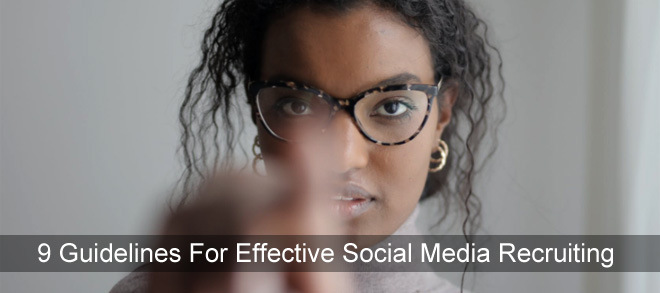It is no longer a strange thing for companies and recruitment agencies to look for qualified candidates via social media. Thousands of jobs are being posted daily on platforms such as Twitter, Facebook, LinkedIn and Google+. Social recruiting is cost effective and allows you to reach a wider audience. In addition, it gives you the opportunity to expose your brand to prospective candidates.
Here are 9 Guidelines For Effective Social Media Recruiting:
1. Create A Content Strategy
The first thing you need to do is decide which social media channels would be most suitable for your brand. Once you have selected your channels, decide who will be responsible for maintaining your accounts. Their responsibilities will include posting new content, engaging prospects and responding to queries. The ‘tone’ of posts should also be considered when coming up with your social media strategy. Depending on the culture of your organization, the tone or persona could be sarcastic, humorous, informal or formal.
2. Highlight Your Organization
Social media offers a great opportunity for sharing your company’s vision, mission and organizational culture with candidates. Share information about projects and events that your company has been involved in. Highlight awards or special recognitions that you have received, and any mentions of your company in mainstream media. It would also be advisable to empower current employees to act as social media evangelists for your organization. Employee profiles or ‘A day in the life of’ videos will give potential candidates a good idea of what it would be like to work in the organization.
3. Use Hashtags
Social media hashtags make it easy for people to locate and share your content. Even people who are not your followers will be able to find content that interests them. Think of a hashtag that is memorable, unique, simple and relevant to your brand. For example, a company such as Microsoft could use #microsoftjobs as their hashtag. You could also consider using other broad hashtags such as #careers, #jobs, #jobopening and #jobsearch in your job postings. This will help you connect with an even wider audience.
Don’t forget to add career specific hashtags like #teachers, #doctors or #engineers for people that will be searching for specific careers. Location hashtags such as #Nairobi, #Vienna or #Madrid can also come in very handy. Your job posting could therefore look something like this: Hello #marketers, we have a #jobopportunity in #Durban for a #lintonspharmacy #marketer
4. Post At The Right Time
The number of people that see your posts will be determined by your time of posting on social media. Therefore, you need to have an effective strategy for scheduling your posts. The good news is that you can use posting services such as Hootsuite, Post Planner or Buffer to schedule your posts to go live at specific times. However, finding the optimum posting time will require extensive testing. For example, you could post at a specific time for one month, then change to a different time the next month. Reviewing your analytics will give you an idea of what works best.
5. Create a LinkedIn Company Page
When it comes to social media recruiting, LinkedIn is the most popular platform with many job seekers, companies and employment agencies. Therefore, if you don’t already have a LinkedIn company page, it would be advisable to create one immediately. Once you have created your page, you need to optimize it for search engines. In your company description, be sure to use keywords that will make it easy for prospective candidates to find you. Don’t forget to choose the right keywords in the ‘Company Specialties’ section.
6. Use Images
According to WebDAM, social media posts containing images or videos create much higher engagement than those without. In addition, more people are likely to remember the message. The good news is that there are numerous royalty-free images out there that you can use. If you want to create custom images, you can use tool such as Canva, Photoshop, PicMonkey and Moldiv.
7. Host a Live Event
Tools such as Google Hangouts and Periscope allow you to host interactive sessions with prospective candidates. You can share your corporate culture and vision by broadcasting live videos of your workplace or company events. Candidates can then be invited to ask questions. To ensure maximum attendance, be sure to promote the live event on all your social media channels.
8. Track All Your Efforts
Keeping track of your social media marketing efforts will give you a good idea of what is working and what isn’t. Some of the metrics you need to keep track of include network growth, social mentions, social engagement, applications completed and offers/hires. It is also very important to search social media to find out what people are saying about your brand.
You can search using your brand name or branded hashtags. Since negative comments could have a negative effect on your brand, be sure to address them quickly before the situation gets out of hand. Some of the tools which could come handy for monitoring include Klout, Social Mention, Hootsuite and Sprout Social.
9. Learn From The Competition
One of the best ways of improving your social media recruitment strategy is by observing what your competitors are doing. Here are some of the questions you need to ask yourself:
- What are their preferred social media channels?
- Which of their posts are producing the highest rate of engagement?
- How are they integrating images and videos into social media?
- Which posting, monitoring and measurement tools are they using?
Conclusion
Prospective candidates need to be handled as consumers. The more effectively you sell the company or job to them, the more interested they are likely to be. Applying the tips above will significantly enhance your chances of success in social media recruiting.
[Images – Main Photo by Andrea Piacquadio from Pexels]
